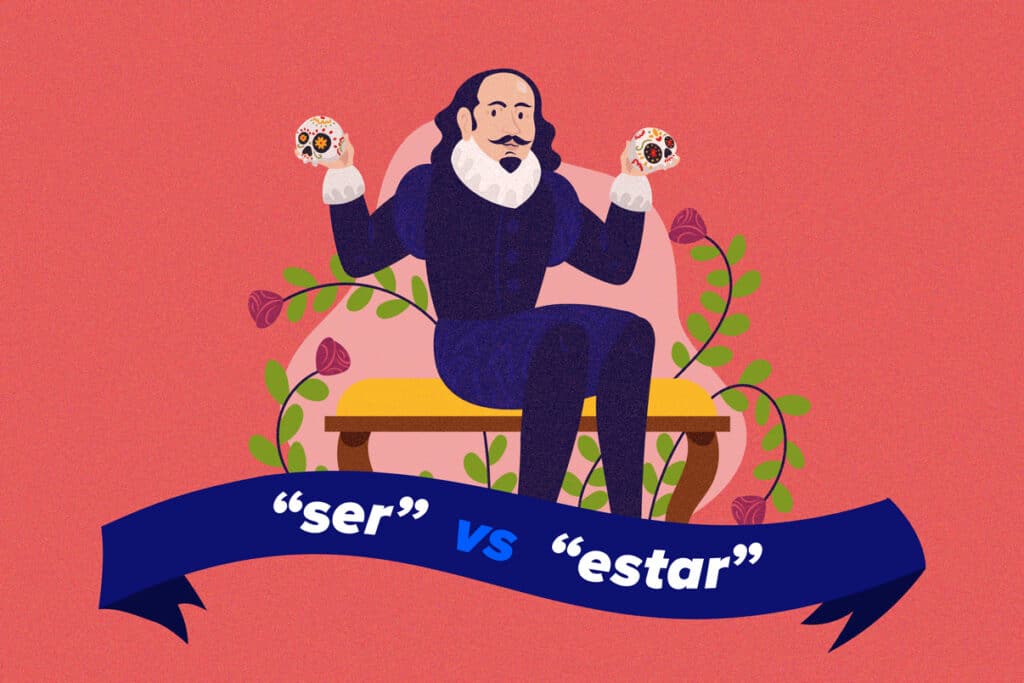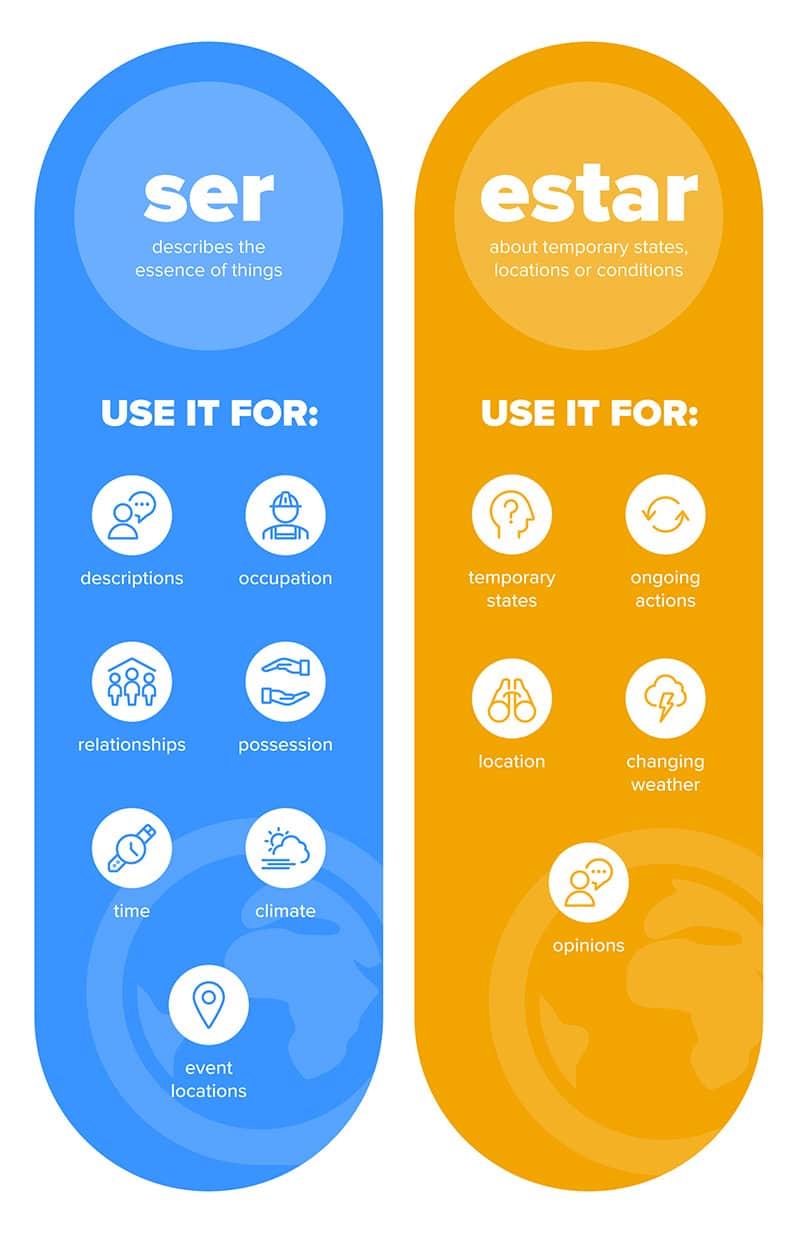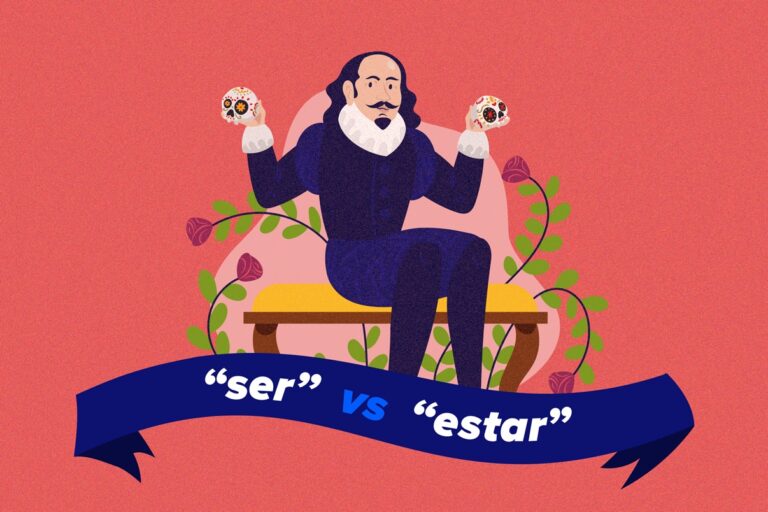
One of the most common things that Spanish learners struggle with is how to tell the difference between two Spanish verbs that both mean “to be”: ser and estar.
This guide will take you through how and when to use these two verbs in Spanish and soon it will come naturally!
Contents
Download:
This blog post is available as a convenient and portable PDF that you
can take anywhere.
Click here to get a copy. (Download)
The Difference Between Ser and Estar
Simply put, ser is used to describe the “essence of things”—the things that make something what it is and are unlikely to change—and estar is used to talk about temporary states, locations or conditions.

When to Use Ser
1. Descriptions
Ser is used for both physical descriptions and character descriptions or personality traits. It is also used to describe where someone is from and their nationality. The same rules apply for things.
Don’t forget to use the correct gender when using adjectives. If you’re a girl, you’ll probably want to use adjectives ending in “a” when describing yourself, if you’re a boy, go for “o.”
2. Occupation
A person’s job is also deemed to contribute to their “essence,” so we also use ser in this case. To ask someone what they do for a living, you can ask, “¿De qué trabajas?” , and you’ll receive the reply, “Soy + [their job].“
Note that you do not use the indefinite article un/una (a/an) when talking about jobs.
3. Relationships
Ser is also used to describe relationships between people.
4. Possession
When talking about things that belong to you or other people, you should always use ser.
5. Time
We also use ser when talking about the time:
6. Event Locations
It is important to know that in most cases, estar will be used when referring to location, but not always. There is a case in which ser is used to refer to location, and that is when talking about where an event is going to take place.
7. Climate
While ser is not used to describe day-to-day weather, it is used to describe the general climate of a place or time.
When to Use Estar
1. Temporary States
Estar is used to describe temporary states such as temporary situations, or temporary physical and emotional states. This would include things like mood or sickness.
2. Ongoing Actions
The verb estar is also used to make the present continuous tense, which is used to describe actions happening in or around the moment of speaking.
These would be temporary actions or conditions that are only happening right now and are assumed to end within the near future.
To make this tense, you need the verb estar in the present tense before the stem of the verb plus “-ando” (-AR verbs) or “-endo” (-IR/-ER verbs).
estoy estamos
estás estáis + Verb stem + (-ando/-endo)
está están
Examples are:
3. Location
When describing where something or someone is, you also need to use our temporary friend estar.
4. Changing Weather
We use estar to describe weather when it is in a temporary state.
5. Opinions
We can also use estar as a descriptive adjective to express an opinion about the physical appearance of someone or something or to indicate that there is something unexpected about them.
-
Ese vestido está muy bonito. (That dress is so beautiful.)
-
¡Qué guapa estás hoy! (You are/look so beautiful today!)
-
Disculpe, mi sopa está muy salada. (Excuse me, my soup is too salty.)
Why Is It Important to Use Ser and Estar Correctly?
While they both technically mean the same thing, it is very important to know the difference between ser and estar so that you can say what you mean to say. Using the wrong form of “to be” can lead to misunderstandings and confusion.
There’s a big difference between being bored and being a boring person, and saying someone is good-looking or a good person.
The best way to pick up on this is by immersing yourself with authentic Spanish media like texts and videos. This will help you realize context and see how these differences are applied.
You can find a variety of helpful sources online or with language learning programs such as FluentU, which allows you to watch native Spanish clips and learn with tools such as interactive subtitles, flashcards and quizzes.

Seeing how these two verbs are used in context by native speakers will improve your Spanish, and get you one step closer to fluency.
Common Mistakes with Ser and Estar
1. Ser Aburrido/a vs. Estar Aburrido/a
Soy aburrido /a means “I’m boring.” This means your entire essence is boring, and you are a boring person. You might want to say es aburrido/a (he/she/it is boring) when describing someone or something, but don’t blame us if someone is insulted by this declaration.
Estoy aburrido /a translates to “I’m bored.” Notice that estar is used for temporary states and this expression demonstrates a temporary state of boredom.
2. Ser Feliz vs. Estar Feliz
Es feliz means someone is a happy person, whereas está feliz means someone is temporarily happy.
Both are useful, but it’s important to know the difference between a perpetually happy person and someone who is just temporarily satisfied.
3. Es Muerto vs. Está Muerto
In this case, you will only ever use está muerto (he’s dead). Always use estar to describe dead things or people.
Death is always seen as a temporary state, so es muerto will never be used.
4. La Fiesta Es vs. La Fiesta Está
As mentioned before, when describing where a planned event takes place we use ser and not estar, even though we’re describing location.
So la fiesta es en mi casa (The party’s at my house) is correct, even though we’re talking about the location of the party. The same applies to any pre-planned event such as meetings, weddings, or parties.
Keep in mind that when describing the party itself, we will indeed use estar: la fiesta está muy divertida. (The party is so fun).”
5. Es Bueno vs. Está Bueno
Está bueno/a translates to he/she is good-looking. This one is definitely useful in some contexts, but should probably be avoided in others.
If you want to say someone is good in general, use es bueno.
Although learning the difference between ser and estar can be difficult, it will come with time and practice.
With constant practice, you’ll know which circumstances require each type of “be.”
Download:
This blog post is available as a convenient and portable PDF that you
can take anywhere.
Click here to get a copy. (Download)



